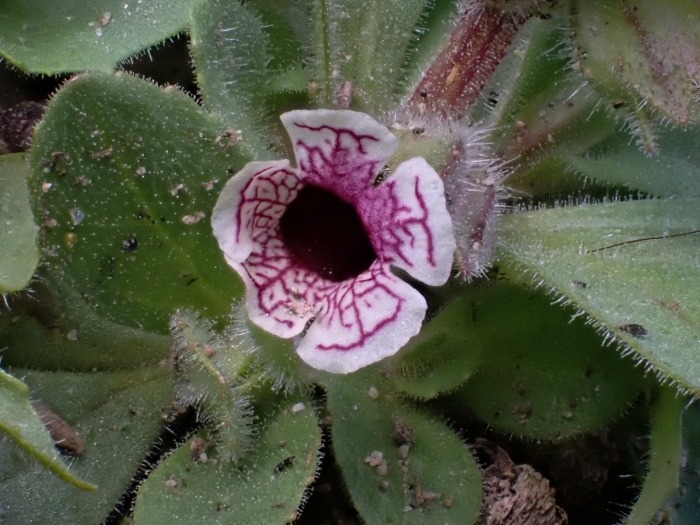Calico Monkeyflower
(Diplacus pictus)
Calico Monkeyflower (Diplacus pictus)
/
/

Madeleine Claire
CC BY 4.0
Image By:
Madeleine Claire
Recorded By:
Copyright:
CC BY 4.0
Copyright Notice:
Photo by: Madeleine Claire | License Type: CC BY 4.0 | License URL: http://creativecommons.org/licenses/by/4.0/ | Rights Holder: Madeleine Claire | Publisher: iNaturalist | Date Created: 2024-03-30T15:24:17-07:00 |
























Estimated Native Range
Summary
Diplacus pictus, commonly known as Calico Monkeyflower, is a perennial herb that is endemic to California, specifically in the foothills above the southeastern San Joaquin Valley in Kern and Tulare Counties. It is often found in open oak woodlands, chaparral, and rocky soils around granite outcrops. This species typically grows to a height of 1-2 feet (30-60 cm) and a similar width, with a mounding form. The Calico Monkeyflower produces distinctive maroon-throated flowers adorned with intricate purple-brown veining from March to May. The blooms are quite showy and attract pollinators such as bees.
The Calico Monkeyflower is valued for its unique and attractive flowers, which make it a desirable addition to native plant gardens and restoration projects. It is also used for educational purposes in conservation and botany due to its endangered status. In cultivation, it requires well-drained soils, preferably with a granitic composition, and it thrives in full sun to partial shade. While it is drought-tolerant once established, regular watering during the first growing season can help establish a strong root system. There are no widely available garden cultivars due to its rarity. Potential problems include habitat loss and competition from invasive species. It is important to source plants from reputable nurseries that do not contribute to the wild population’s decline.CC BY-SA 4.0
The Calico Monkeyflower is valued for its unique and attractive flowers, which make it a desirable addition to native plant gardens and restoration projects. It is also used for educational purposes in conservation and botany due to its endangered status. In cultivation, it requires well-drained soils, preferably with a granitic composition, and it thrives in full sun to partial shade. While it is drought-tolerant once established, regular watering during the first growing season can help establish a strong root system. There are no widely available garden cultivars due to its rarity. Potential problems include habitat loss and competition from invasive species. It is important to source plants from reputable nurseries that do not contribute to the wild population’s decline.CC BY-SA 4.0
Plant Description
- Plant Type: Herb
- Height: 0.3-0.5 feet
- Width: 0.25-0.75 feet
- Growth Rate: Moderate
- Flower Color: Red, White
- Flowering Season: Spring, Summer
- Leaf Retention: Deciduous
Growth Requirements
- Sun: Full Sun, Part Shade
- Water: Medium
- Drainage: Fast, Medium
Common Uses
Bee Garden, Butterfly Garden, Deer Resistant, Drought Tolerant, Low Maintenance, Rock Garden
Natural Habitat
Open oak woodlands, chaparral, and rocky soils around granite outcrops
Other Names
Common Names: Painted Monkeyflower
Scientific Names: , Diplacus pictus, Eunanus pictus, Eunanus pictus, Mimulus pictus,
GBIF Accepted Name: